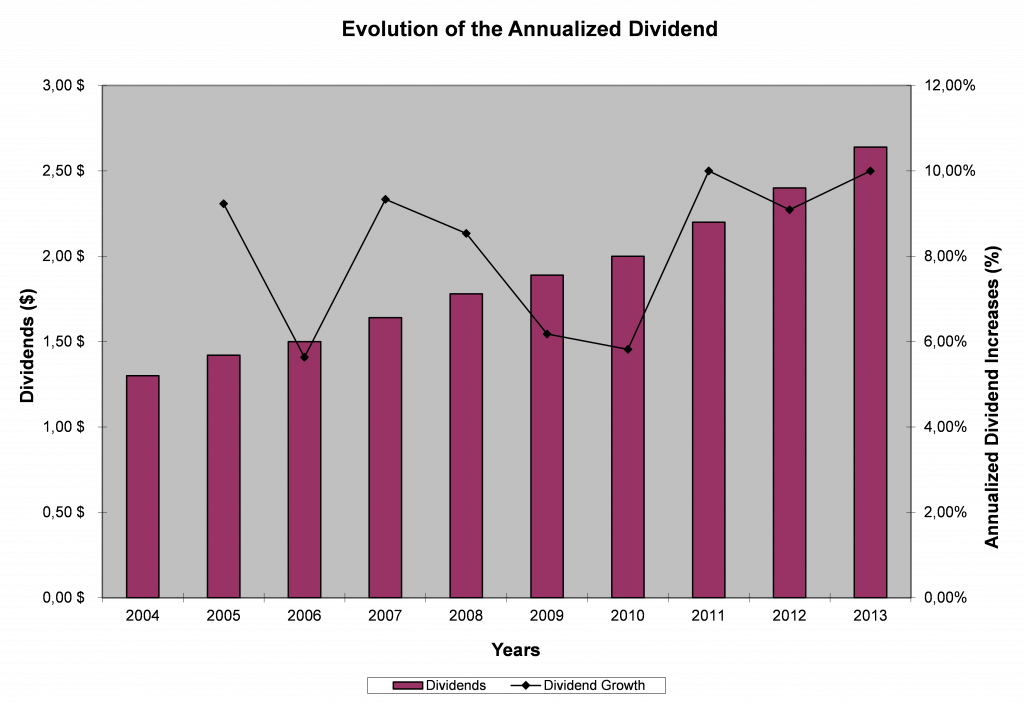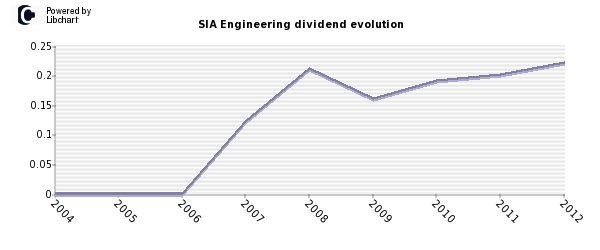Dividend Engineering
Post on: 3 Май, 2015 No Comment

As part of my schedule of dividend stock purchases, I recently initiated a small position in Chevron Corp. the oil company.
After having topped my position in Baxter International four weeks ago, I was on the look out for a new purchase.
So, for this purchase, I’ve added 8 shares of Chevron for a little more than CA$1000.
Yes, the Canadian dollar has significantly dropped with respect to the US dollar, making the purchase of US dividend stocks more expensive.
However, even though I get hit when I purchase US stocks, I get a corresponding boost when the dividends paid in US dollars are converted back into Canadian dollars. For me, since I dont intend to sell my stocks in the foreseeable future, the exchange rate has limited impact on my purchase decisions.
With this purchase, Chevron represents only a small percentage of my dividend portfolio, that is 1.06%. Also, by having initiated a position in a new stock, I now own 41 different dividend stocks in my dividend portfolio.
Why Chevron?
When I make a purchase according to my scheduled purchase plan, I try, whenever possible, to buy stocks which offer the best value at the time of purchase. Though stock markets can be generally overvalued, there are always pockets of value here and there. When I intend to make a new purchase, I focus on these pockets of value.
With all the recent bad news afflicting energy stocks, and more particularly oil stocks, I decided to take a closer look at the oil sector, feeling that it would probably provide good value.
I had four candidates in mind before finally pulling the trigger on Chevron. They were:
- Chevron (NYSE: CVX)
- ConocoPhillips (NYSE: COP)
- Exxon Mobil (NYSE: XOM)
- Suncor Energy (TSX: SU, NYSE: SU)
Using current yields and estimated dividend growth rates, I concluded that ConocoPhillips was providing the best value, followed by Chevron.
In the end though, I finally leaned towards Chevron.
First, currently, Chevron has a lower payout ratio. If oil prices continue to remain low, or worse, drop, a lower payout ratio means that Chevrons dividend is safer. I like to buy undervalued stocks but I tend to prefer a lower yield if it means a safer dividend.
Second, Chevron is larger than ConocoPhillips and also more diversified. In that sense, Chevron is still a fully integrated oil company while ConocoPhillips is now only an exploration and production company due to the spin off of its refining business as Phillips 66 (PSX). Being larger and more diversified, Chevron is, in my view, better positioned to weather the current storm than ConocoPhillips.
My Next Move
For my next purchase, I will keep a close eye on oil stocks. In that sense, I havent completely discounted ConocoPhillips. If oil prices stabilize, I might very well initiate a stake in ConocoPhillips too. I remain convinced that the stock in undervalued and the yield is enticing. Otherwise, I might increase my stake in Chevron.
Other pockets where I see value are Canadian bank stocks and US machinery stocks, more particularly John Deere and Caterpillar.
However, if you have other ideas, please share them with us!
See you in four weeks for my next purchase.
On the second day of February, Groundhog Day is celebrated throughout parts of the United States and Canada.
During Groundhog Day, it is the tradition to wake up a groundhog, which is hibernating, to see whether or not the sleepy rodent will see its shadow. If the groundhog sees its shadow, winter will last for another 6 weeks. Otherwise, it will be an early spring.
I dont know whether the groundhog saw its shadow this year but it clearly saw an avalanche of dividend increases.
Out of the 40 dividend-paying companies which stocks I own, 9 of them, almost 25% of them, announced a dividend increase last month.
And the dividend increases started, you guessed it, on Groundhog Day!
United Technologies Corp.
On February 2, United Technologies (NYSE: UTX) increased its quarterly dividend by 8.5%, from $0.59 per share to $0.64 per share.
This was a pretty good increase by the industrial conglomerate.
Also, for reasons which I dont really understand, United Technologies increases its dividend every 5 quarters.
BCE Inc.
On February 5, BCE (TSX: BCE, NYSE: BCE) increased its quarterly dividend by 5.3%, from CA$0.6175 per share to CA$0.65 per share.
Though a 5.3% dividend increase is not spectacular, combined with a yield around 4.70%, this is not bad at all.
Union Pacific Corp.
On February 5, Union Pacific (NYSE: UNP) increased its quarterly dividend by 10.0%, from $0.50 per share to $0.55 per share.
For Union Pacific, this years dividend increase was yet another double-digit increase. Over the last 5 years, the quarterly dividend has more than tripled, skyrocketing from $0.1350 per share in February 2010 to $0.55 in February 2015.
And all that from a railroad company!
Cisco Systems, Inc.
On February 11, Cisco Systems (NASDAQ: CSCO) increased its quarterly dividend by 10.5%, from $0.19 per share to $0.21 per share.
Though Cisco Systems is relatively new to paying dividends it paid its first dividend in 2011 with this most recent increase, it seems that it has established a pattern of increasing its quarterly dividend every February.
With a yield near 2.8%, Cisco is an interesting dividend stock.
AbbVie Inc.
On February 19, AbbVie (NYSE: ABBV) increased its quarterly dividend by 4.1%, from $0.49 per share to $0.51 per share.
In all honesty, this increase was unexpected. Since being spun off from Abbott Laboratories, AbbVie did not exhibit any pattern of regular or annual dividend increase. In that sense, AbbVie also increased its dividend last quarter.

We will see over time what will be the dividend increase pattern of AbbVie. In the meantime, I will take every increase.
Coca-Cola Company
On February 19, Coca-Cola (NYSE: KO) increased its quarterly dividend by 8.2%, from $0.3050 per share to $0.33 per share.
Another steady increase by the beverage giant.
Year in, year out, Coca-Cola seems to increase its dividend by about 7 to 8%. That is probably one of the reasons why Warren Buffett keeps its Coca-Cola stake intact. I would do the same.
Wal-Mart Stores, Inc.
On February 19, Wal-Mart (NYSE: WMT) increased its quarterly dividend by 2.1%, from $0.48 per share to $0.49 per share.
Of all the dividend increases that have been announced in February, Wal-Marts increase was probably the most disappointing. With a payout ratio under 50%, Wal-Mart could have done much better.
Royal Bank of Canada
On February 24, Royal Bank of Canada (TSX: RY, NYSE: RY) increased its quarterly dividend by 2.3%, from CA$0.75 per share to CA$0.77 per share.
At first sight, a 2.3% dividend increase might not seem much. But, given the fact that Royal Bank of Canada typically increases its dividend twice a year, the 2.3% increase must be added to the previous 5.6% increase in August 2014. Over the last 12 months, Royal Bank of Canada has increased its quarterly dividend by a healthy 8.5%, from CA$0.71 per share to CA$0.77 per share.
Combined with a current yield hovering around 3.90%, these are very interesting numbers!
TD Bank
On February 26, TD Bank (TSX: TD, NYSE: TD) increased its quarterly dividend by 8.5%, from CA$0.47 per share to CA$0.51 per share.
And last but not least, TD Bank rewarded us with yet another dividend increase.
TD Bank, like most Canadian banks, tends to increase its dividend twice a year. Each increase is generally in the range of 3 to 6%. However, contrary to Royal Bank, TD Bank did not increase its dividend last August. So this increase is larger than usual.
Final Thoughts
What to say?
Dividend investing is about buying dividend stocks and collecting their ever growing dividend streams.
I think getting 9 dividend increases in a single month shows, yet again, that dividend investing does work.
As for my friend the groundhog, he is on the watch for other dividend increases.
Stay tuned!
Photo by Marumari (source: Wikipedia )














